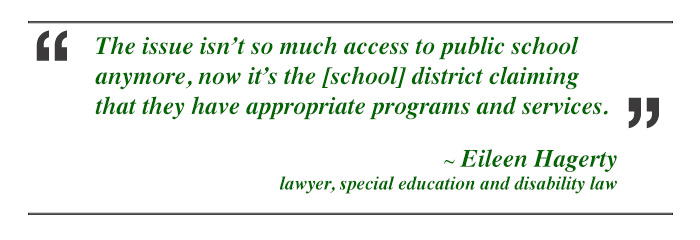| Funding Special Education Benefits Us All | |
| by Angela M. Timpone | |
 |
Last fall, while I watched the Norwich University football team win 19–9 against Gallaudet University, I overheard words like “dumb,” “stupid,” and “retard” from NU spectators. These words weren’t comments on the Gallaudet players’ performance. The derogatory remarks referred to the players’ disabilities; Gallaudet students are deaf or hard of hearing. Disability discrimination is often more socially acceptable than high-profile race discrimination and continues to plague our city streets, our universities, and our classrooms with little reflection or compassion. We chuckle or look away when remarks fly about a person’s disability. In 1975 President Gerald Ford signed one of the most important civil rights laws, the Education for All Handicapped Children Act (EAHCA), which entitles all children ages 3–21, regardless of their disability, to a Free Appropriate Public Education (FAPE) in the Least Restrictive Environment (LRE). Before the groundbreaking legislation, “More than 1 million students were excluded from public schools, and another 3.5 million did not receive appropriate services. Many states had laws excluding certain students, including those who were blind, deaf, or labeled ‘emotionally disturbed’ or ‘mentally retarded, ’” according to the National Council for Disabilities (NCD). |
| In 1997, the EAHCA underwent an overhaul, expanding from an access-to-education law to a law that increased expectations for students with disabilities, ensuring, among other things, that students have “access to the general education curriculum in the regular classroom, to the maximum extent possible. ” The new statue, now named Individuals with Disabilities Education Act (IDEA), stated that “improving educational results for children with disabilities is an essential element of our national policy of ensuring equality of opportunity, full participation, independent living, and economic self-sufficiency for individuals with disabilities. ” IDEA was reauthorized with some changes in 2004 and is the current federal law.
In Vermont, as education budget debates heat up, elected officials and community members often ask why we spend so much money on special education. Students with disabilities have unique needs that require specialized programs to be educated and participate in school. In an interview with Vermont Woman, Dr. Susan Bruce, Boston College special education professor, went even further, stating that “all people are a value. ” We don’t ask the same financial questions about students of color or students in poverty, but we segregate students with disabilities and target the cost of their educational programs. How does Vermont pay the bill? Deputy Secretary Bill Talbott of the Vermont Agency of Education explained that the state tries to take away the local financial burden of special education with a funding mechanism similar to insurance reimbursement. According to Talbott, for the first $50,000 of a student’s direct and related services required by his or her Individualized Education Program (IEP), the state shares the cost with the local school district: just under 60 percent is state funded and about 40 percent is locally funded. The school district submits claims for services provided every quarter, and the state reimburses the district. When a student requires, through his or her IEP, services that exceed $50,000, the state splits the additional cost, with 90 percent funded by the state and 10 percent locally funded. The state then receives federal block grants to cover some of the costs of special education along with Medicaid funds for educational prevention programs for general education students.
Vermont has its own Special Education Rules that were most recently adopted in 2013, which school districts and parents follow to ensure FAPE in LRE. Both the Vermont Special Education Rules and IDEA have requirements for special education eligibility, developing an IEP, parent involvement, procedural safeguards, and implementation of services. Vermont special education eligibility is determined when a student passes two gateways: first a child (ages 3–21) must be diagnosed with a disability. If diagnosed, the student then needs to pass a second gateway: the student must be evaluated by his or her local school district and found to be “significantly below grade norms (15% or below) ” in three or more areas of school performance, also known as adverse effect, along with needing a specialized program to access the general education curriculum. If eligibility is found, a team, which includes school staff and parents, convenes to develop an IEP. Hagerty said that her firm consults parents “behind the scenes” on how to navigate special education law and represents parents in contentious situations like mediation and/or due process hearings. According to the National Council on Disabilities’ report Back to School on Civil Rights, “enforcement of the law is the burden of parents who too often must invoke formal complaint procedures and due process hearings, including expensive and time-consuming litigation, to obtain the appropriate services and supports to which their children are entitled under the law. Many parents with limited resources are unable to challenge violations successfully when they occur. ” Hagerty explained that “the issue isn’t so much access to public school anymore, now it’s the district claiming that they have appropriate programs and services. ” Disagreements between school districts and parents cost both parties: school districts use taxpayer money for litigation, and parents often remortgage or borrow to pay hefty legal bills. According to Hagerty, the legal bills for a case that goes all the way to a due process hearing can range from $40,000 to $50,000 per side. To avoid costly litigation and missteps in building a working relationship with school districts, some parents hire an educational advocate like Janet Thibeau to help them navigate the special education system and process. Thibeau, an educational advocate and family coach, spoke about the stress parents experience when their child has a disability: “Not all students come in a nice package. Sometimes there is no one answer, and it’s a maze with the child’s future at the end. ” The financial costs to parents for advocacy services and outside evaluations can range from $5,000 to $20,000 per year, depending on how contentious or amicable the school district is. Not to mention the other costs incurred by families: loss of work days going to school meetings, doctor appointments, and expert evaluations; impact on siblings; the social stigma and isolation many families feel when their child doesn’t fit into the “normal” box; and the overall emotional toll—divorce rates are higher for families with children with disabilities. “When you have a child with a disability, there are risks on the way to adulthood, ” said Thibeau. She noted that people with disabilities are more likely to be in prison, committed to a mental health facility, on welfare, and/or not working. According to Jay Diaz, a Vermont Legal Aid attorney and coauthor of the recent report Kicked Out!, “Vermont’s students with disabilities and students of color were two to three times more likely to be excluded from school through suspension and expulsion. ” Kicked Out! reported that “disability Rights Vermont found that up to 90% of the youth in the Woodside Juvenile Rehabilitation Center are students with disabilities. ” The value of special education dollars spent on appropriate specialized programs far outweighs the alternative to not providing adequate programs for students. Thibeau said that the stress and risks “could be managed by giving children with special needs opportunities to become productive members of society.”
Dr. Temple Grandin, Colorado State University professor of animal science, livestock handling facilities designer, and autism activist, travels the world lecturing about autism and the need for encouraging different ways of thinking to solve the world’s must complex problems. In a 2010 TED Talk, Grandin said, “The world needs different kinds of minds to work together. ” Grandin, who has autism, talked about the education system needing to shape the interests of students with autism into productive adults. Such individuals have the ability to work on tough issues because, with their unique brain wiring, they can see details that others, with more average brain development, can’t identify. At this time, Bruce hopes for another shift in special education—teaching to a student’s unique strengths not his or her deficits. Bruce teaches graduate students studying special education for children with severe disabilities. She is an expert in children with multiple disabilities, in particular children who are congenitally deaf and blind. Bruce said her students often talk about why they work with children with disabilities and a common remark is that they “can learn from people with disabilities by watching them experience the world, it guides us.” Bruce advocates breaking down barriers between special education and general education by moving to a coteaching model, with general education teachers getting some preparation in special education and working directly in classrooms with special education teachers. Diaz said that “Vermont leans towards inclusionary [programs] because we don’t have resources or numbers to support alternative placements. ” But Bruce warns that “a paraprofessional [or aide] and the kid in the back of the classroom is not inclusion. ” Claudia Pringles is a special needs attorney, copresident of the Vermont Autism Task Force, and parent to 15-year-old Katrina and 13-year-old Jeni Lili. “Most people don’t plan on having a child with special needs, ” Pringles said, referring to Katrina, who has been diagnosed with autism spectrum disorder (ASD). She went on to say that having a child with ASD is “very involving and a financial impact. ” A first-generation Argentinean Hispanic and the first family member to finish college and graduate from law school, Pringles had big goals for herself. But she had to “put aside her own ambitions, ” she said, when Katrina was diagnosed. Instead, Pringles built her own law practice and advocates for autism legislation. “I couldn’t have a regular job. I need to be flexible for [Katrina]. ” Katrina needs constant supervision and specialized services at home and at school. Pringles talked not only about the challenges for herself but also for Jeni Lili, “It’s challenging for her. [Jeni Lili] can’t interact or play with [Katrina]. ” Referring to her experience with Katrina’s school team, she said, “I’ve been very fortunate. ” Pringles explained that she was the “only permanent IEP member, ” so she works tirelessly to advocate while maintaining a good working relationship with her school. Katrina, an avid photographer, reads at grade level, comprehends at the elementary school level, participates in the yearbook club, and is on the cross-country ski team. Pringle discussed her long-term goals for Katrina: “Plan A is up to her. ” As for plan B, they bought a house with an apartment in downtown Montpelier so that, if needed, Katrina can live there independently. |
|
| is a certified educational advocate and family coach serving Vermont and Massachusetts and founder of Camp Kaleidoscope, a camp for families with children with autism. She lives in Montpelier, Vermont, with her partner, Robert Gowans, and three children.
|
|

